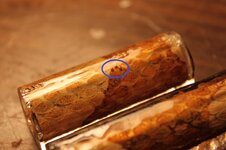Jmhoff10500
Member
So the snakeskins i have must have been from a snake that was owned by a magician because no matter how invisible they are before, bubble often form!

This is the first skin that has done this in a while but it stumps me every time and it is a huge inconvenience cause i have to remove the resin and recast the skin...
So here is my procedure and if any of you guys know what is up, please let me know!!!
First i wrap the skins on painted tubes with CA and let them sit for almost 2 weeks to insure there is no more degassing. then from there i paint the tubes in raw CC PR, place in the resinsaver mold, slowly mix in PR Catalyst to insure no bubbles mix in, then slowly pour it into the mold, place on vibration table, let cure over night, post cure in homemade heat box, then pull them out of the mold.
The bubbles look too big to be degassing or preexisting bubbles in the resin, so im lost...
It seems like a shame to not use the ones with bubbles and a huge process to recast so if you guys have any ideas, please let me know!!! Thanks!

This is the first skin that has done this in a while but it stumps me every time and it is a huge inconvenience cause i have to remove the resin and recast the skin...
So here is my procedure and if any of you guys know what is up, please let me know!!!
First i wrap the skins on painted tubes with CA and let them sit for almost 2 weeks to insure there is no more degassing. then from there i paint the tubes in raw CC PR, place in the resinsaver mold, slowly mix in PR Catalyst to insure no bubbles mix in, then slowly pour it into the mold, place on vibration table, let cure over night, post cure in homemade heat box, then pull them out of the mold.
The bubbles look too big to be degassing or preexisting bubbles in the resin, so im lost...
It seems like a shame to not use the ones with bubbles and a huge process to recast so if you guys have any ideas, please let me know!!! Thanks!
